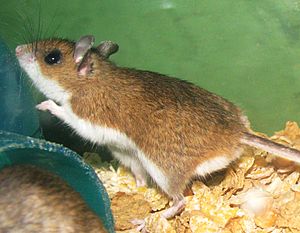Peromyscus facts for kids
Quick facts for kids PeromyscusTemporal range: Late Miocene – Recent
|
|
|---|---|
 |
|
| Peromyscus maniculatus | |
| Scientific classification |
|
| Kingdom: | Animalia |
| Phylum: | Chordata |
| Class: | Mammalia |
| Order: | Rodentia |
| Family: | Cricetidae |
| Subfamily: | Neotominae |
| Tribe: | Reithrodontomyini |
| Genus: | Peromyscus Gloger, 1841 |
| Species | |
|
See text |
|
Peromyscus is a group of rodents often called deer mice. Don't confuse them with "mouse deer," which are tiny hoofed animals. These mice are "New World mice," meaning they live in North and South America. They are not closely related to the common house mouse you might know.
Deer mice look different from house mice. They have bigger eyes and usually two-tone fur. Their backs are darker, and their bellies and legs are white. The name Peromyscus comes from Greek words meaning "booted mouse," which describes their coloring. They are also great jumpers and runners, much more agile than house mice. This agility is why they are called "deer mice," like the graceful deer.
The most common types of deer mice in the United States are P. maniculatus and P. leucopus. These small animals are actually the most common mammals in the United States. In the western U.S., they are known for carrying certain viruses.
Contents
Deer mice and human health
Hantavirus
Deer mice became well-known when scientists discovered they carry a virus called Sin Nombre hantavirus. This virus can make people very sick. It's important to be careful around mouse droppings or nests, especially in closed spaces like sheds or cabins. Always wear gloves and a mask if you need to clean areas where mice might have been.
Lyme disease
Deer mice can also carry the bacteria that cause Lyme disease. This disease is spread to humans by ticks. When ticks bite an infected deer mouse, they can pick up the bacteria. Then, if that tick bites a person, it can pass the disease to them.
Other diseases
Deer mice can carry other germs too. These include bacteria that cause Ehrlichiosis and babesiosis. It's always a good idea to avoid direct contact with wild mice and their habitats.
Studying deer mice in labs
Even though deer mice live in the wild, they are also easy to raise and keep in special labs. They are more active than common lab mice, but scientists like to study them. They are often preferred over standard lab mice or rats for certain research.
Scientists use deer mice to learn about many things. They help us understand infectious diseases, how different species form, and how chromosomes and genetics work. They are also useful for studying ecology (how living things interact with their environment) and evolution.
One interesting fact is that deer mice live much longer than regular lab mice. They can live for 5 to 7 years, while lab mice usually only live for about 3 years. This makes them great for studying how animals age.
The Peromyscus Genetic Stock Center at the University of South Carolina is a special place. It was started in 1985 to raise different types of deer mice for research and education. They have several species, like the California mouse and Peromyscus maniculatus. These mice show different traits, like unique behaviors or fur colors, which helps scientists learn even more.
Many types of deer mice
There are many different species of Peromyscus deer mice. Scientists group them based on how closely they are related. Here are a few examples:
- California mouse – P. californicus
- Cactus mouse – P. eremicus
- North American deer mouse – P. maniculatus
- White-footed mouse – P. leucopus
- Brush mouse – P. boylii
- Pinyon mouse – P. truei
- Mexican deer mouse – P. mexicanus
Some species, like the Angel Island mouse and Pemberton's deer mouse, are now extinct. This means they no longer exist on Earth.
See also
 In Spanish: Peromyscus para niños
In Spanish: Peromyscus para niños

